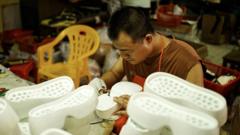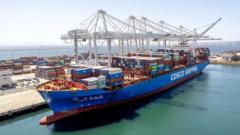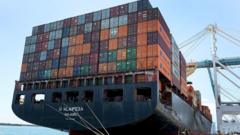Small businesses in China, particularly those exporting to the US, face tough challenges due to President Trump's tariffs. With products piling up and production halting, concerns about their future grow, as the trade war has far-reaching implications for economies on both sides.
The Impact of Trump's Tariffs on Chinese Small Businesses

The Impact of Trump's Tariffs on Chinese Small Businesses
Small businesses in China report significant struggles due to US tariffs, highlighting an economic crisis exacerbated by the ongoing trade war.
In the bustling halls of the Canton Fair in Guangzhou, small business owners like Lionel Xu of Sorbo Technology express their frustration and uncertainty. “This is so hard for us,” says Xu, whose company’s mosquito repellent kits once thrived in US markets but now gather dust in a warehouse, thanks to President Donald Trump’s stringent 145% tariffs on Chinese imports.
Around half of Sorbo’s production is designated for the US market, making the ongoing trade war particularly devastating. “We are worried. What if Trump doesn’t change his mind? That will be a dangerous thing for our factory,” Xu reflects. The situation is echoed by many other vendors at the fair, including Amy, who reports that her ice cream maker company has also halted production: “All the products are in the warehouse.”
Despite moments of optimism when Trump temporarily paused some tariffs last week, the trade levies against Chinese goods remained. This retaliatory exchange has left many traders bewildered, with goods meant for American customers now piling up across Chinese factories. As American firms struggle to manage rising costs, US households may soon feel the pinch as the supply chain crisis unfolds.
The looming uncertainty has noticeably strained China’s economy, which heavily relies on exports that accounted for approximately 50% of its growth in recent years. While some Chinese businesses are eyeing opportunities in domestic markets or other regions like Europe and Saudi Arabia, many workers are already feeling the effects of the downturn. Reports from laborers in garment factories reveal wages slashed by half, highlighting an unsettling reality where finding work has become increasingly challenging.
Amidst this turmoil, the Chinese government insists it will fight the trade war “until the end,” maintaining a defiant posture against US demands. Even as some business owners express a preference for focusing on domestic consumers, the broader economic picture is murky. Wealthier Chinese consumers, hesitant to spend in the face of falling property prices and economic instability, further complicate recovery efforts.
The ongoing tariff saga continues to strain both economies, with potential recession risks on the horizon for the United States. As diplomatic communication between Washington and Beijing dwindles, optimism wanes for a swift resolution. In the meantime, Chinese businesses must navigate these uncertain waters, pivoting to new markets while grappling with the implications of an increasingly polarized trade environment. The unfolding narrative underscores a profound economic crisis that is reverberating beyond borders, directly affecting countless lives in both countries.






















